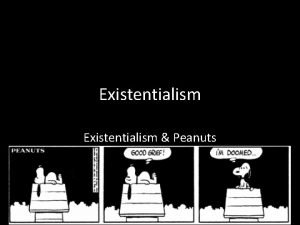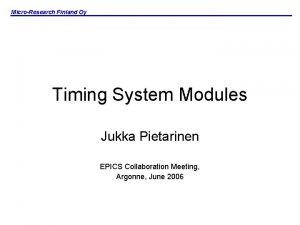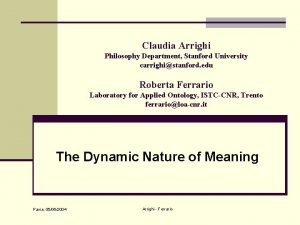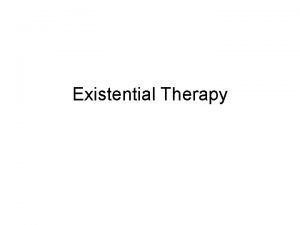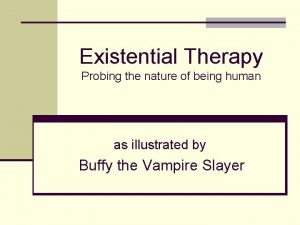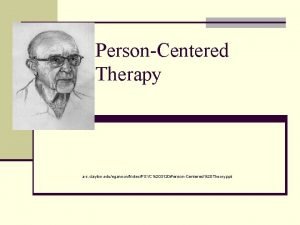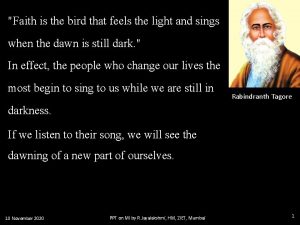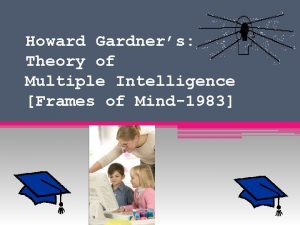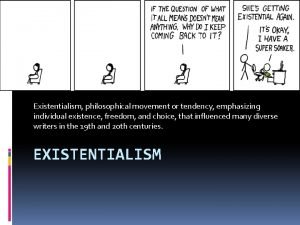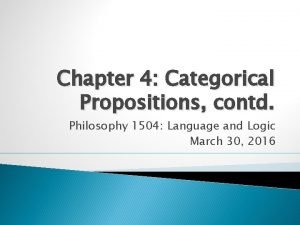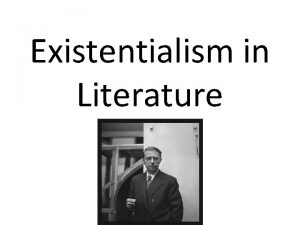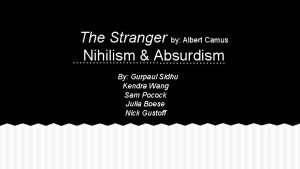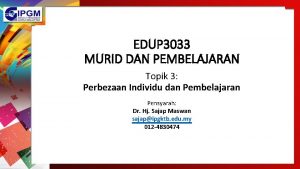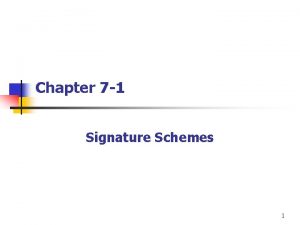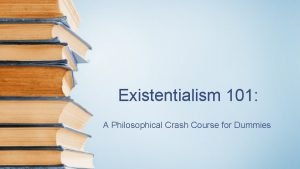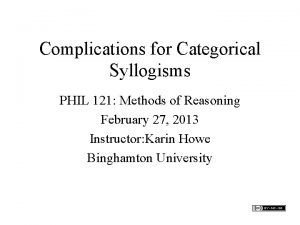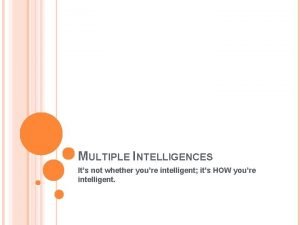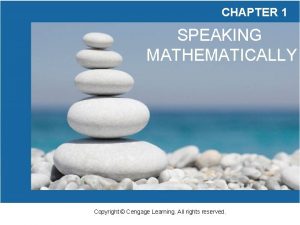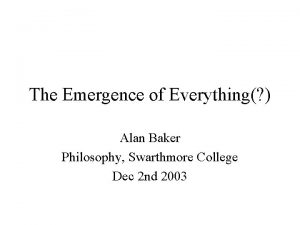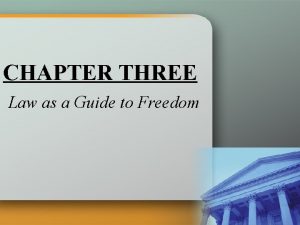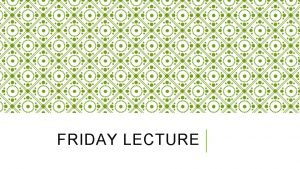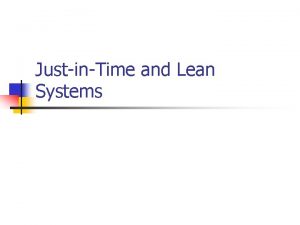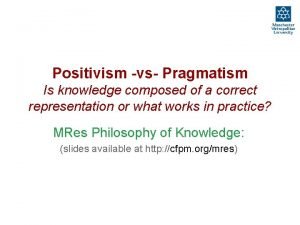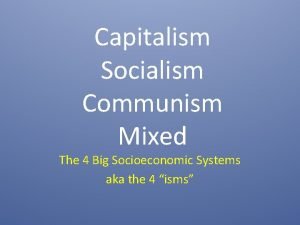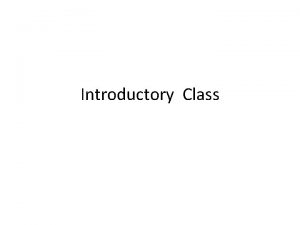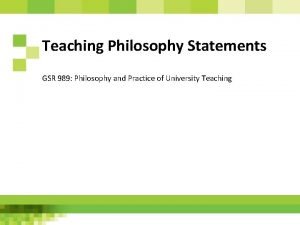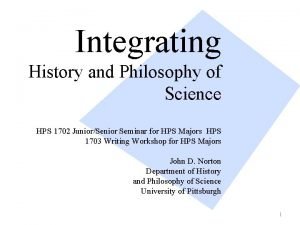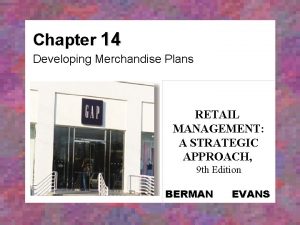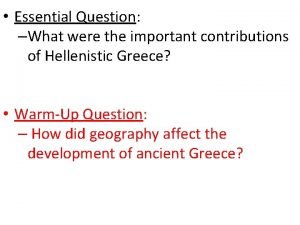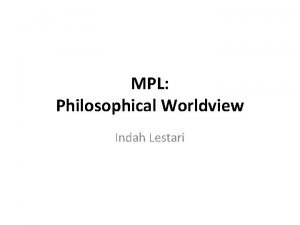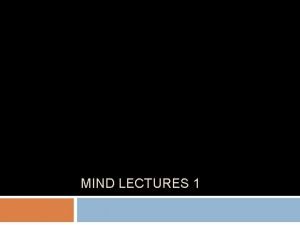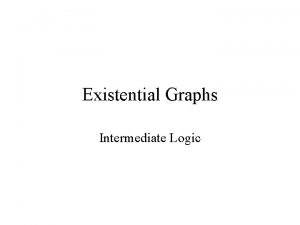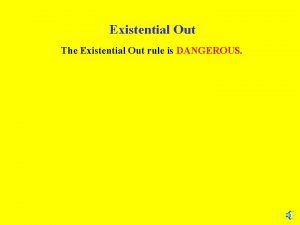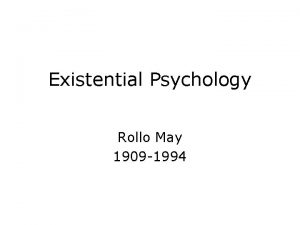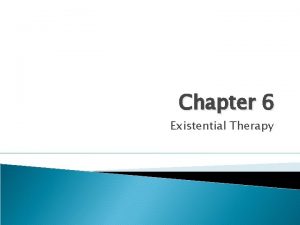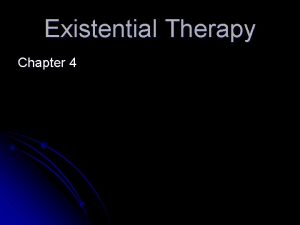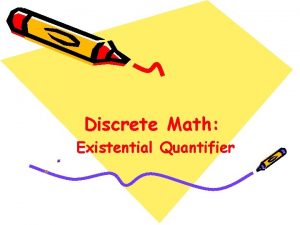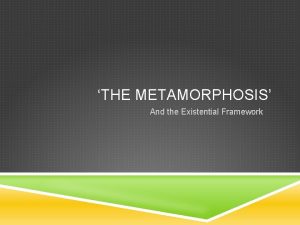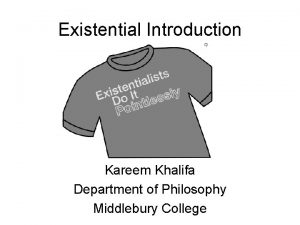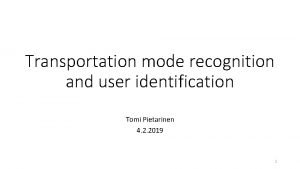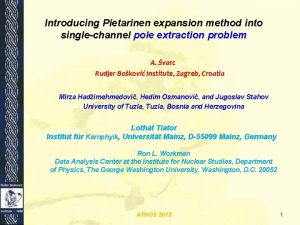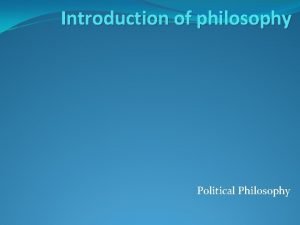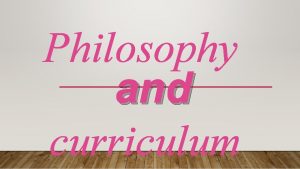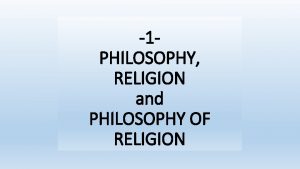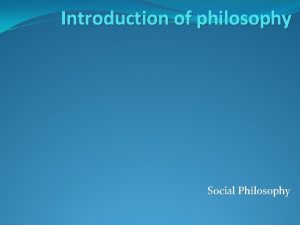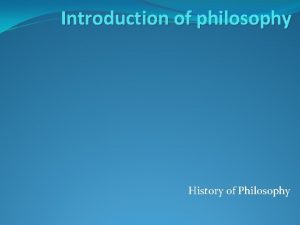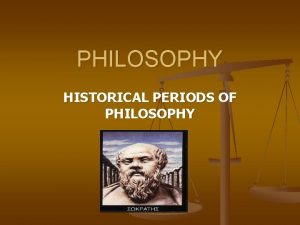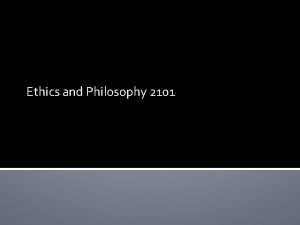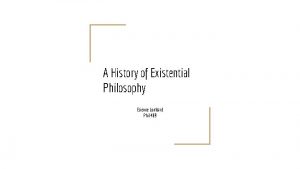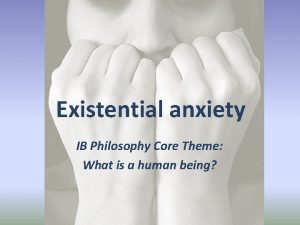IndependenceFriendly Existential Graphs AhtiVeikko Pietarinen Department of Philosophy
















































- Slides: 48

Independence-Friendly Existential Graphs Ahti-Veikko Pietarinen Department of Philosophy University of Helsinki 29 April 2004 1

Outline 1. 2. 3. 4. 5. Symbolic vs. diagrammatic logic Independence-friendly (IF) logic Existential graphs (EG) IF EGs Conclusions 2

Symbolic vs. diagrammatic logical representations • 20 th century: Mainly symbolic logic • 19 th century: Lots of diagrammatic logics (Venn, Kempe, Sylvester, Peirce, …) • Earlier: (Euler, Bruno, Vives, …) • 21 st century: ? • Diagrams are not conventional like symbols, but iconic 3

Independence-friendly (IF) logic Jaakko Hintikka: • ”The real source of the expressive power of firstorder logic lies not in the notion of quantifier per se, but in the idea of a dependent quantifier” Hintikka, Jaakko (1996: 47): The Principles of Mathematics Revisited, CUP. 4

What is IF logic? • Allow explicit independence between quantifiers: • For all x there exists y ”independently of” x • Skolem functions: not but • Semantic games of imperfect information – Arrays of Skolem functions = winning strategies 5

Henkin quantifiers • Henkin (1959): true in M iff Leon Henkin (1961): ”Some Remarks on Infinitely Long Formulas”, Infinistic Methods. Proceedings of the Symposium on Foundations of Mathematics, Pergamon Press, 167 -183. 6

Henkin quantifiers • Krynicki normal forms (1993) reduce to 7

Branching quantifiers • “Some relative of every villager and some friend of every townsman hate each other” (Hintikka 1974) • “Most linguists and most logicians admire each other” (Barwise 1979) 8

Language of IF logic • Let be in the scope of Given wffs of • • We may even have and are Sandu, G. & Pietarinen, A. -V. (2001): “Partiality and Games: Propositional Logic”, Logic Journal of the IGPL 9, 107 -127. 9

Binding vs. priority scope • Binding scope: The reach of any single instantiation of values • Priority scope: Logical ordering of quantifiers • In FOL these go together, in IF logic not • Limitation of the Frege-Russell concept of logic 10

Game-theoretic semantics • Henkin (1961): “Imagine, for instance, a “game” in which a First Player and a Second Player alternate in choosing an element from a set I; the infinite sequence generated by this alternation of choices then determines the winner” Leon Henkin (1961): ”Some Remarks on Infinitely Long Formulas”, Infinistic Methods. 11 Proceedings of the Symposium on Foundations of Mathematics, Pergamon Press, 167 -183.

Game-theoretic semantics • Hintikka (1973): a game between • Non-cooperative, finite, zero-sum games • Complete but possibly imperfect information and imperfect recall • FOL, modal logic, dynamic logic, … A. -V. Pietarinen (2004): “Some Games Logic Plays”, Logic, Thought and Action, Kluwer 12

Game-theoretic semantics then chooses then and In IF logic strong game negation, not classical, weak contradictory negation! 13

Game-theoretic semantics • Winning conventions is a win for if • Winning strategies is true in iff there exists a winning strategy for in is false in iff there exists a winning strategy for in 14

Imperfect information • In any player chooses “without knowing” previous choices in W • Induces equivalence relations between game histories • Information sets in extensive-form games • Non-determined formulas 15

Extensive-form games • • • Interactive move-by-move setting Provides derivational histories Explicit representation of information flow Imperfect recall (memory) Partial semantics A. -V. Pietarinen (2004): “Semantic Games in Logic and Epistemology”, Logic, Epistemology and the Unity of Science, Kluwer Academics. 16

Basic properties of IF logic • Agrees with the -fragment of the second -order logic • Compactness • Downwards Löwenheim-Skolem • Not recursively axiomatisable • Expresses NP-complete properties on finite models 17

Existential Graphs Charles S. Peirce (1839 -1914): • ”I do not think I ever reflect in words: I employ visual diagrams, firstly, because this way of thinking is my natural language of selfcommunion, and secondly, because I am convinced that it is the best system for the purpose” (MS 619: 8, 1909) 18

Existential Graphs • Entitative Graphs (1886) → Existential Graphs (EG, 1895) • The goal is not to have “heterogeneous” logic but iconic, diagrammatic, graphical • Origins in algebra of relatives and valental chemistry • EGs “put before us moving-pictures of thought” (1906) A. -V. Pietarinen (2004): ”Peirce’s Magic Lantern I: Moving Pictures of Thought”, Transactions of the C. S. Peirce Society 19

Alpha, Beta, Gamma… • Alpha graphs = propositional logic • Beta graphs ≈ predicate logic /w identity w/o constants, function symbols • Gamma graphs = – Modalities (possibility, necessity, knowledge, time…, “tinctures”, 1908) – Higher-order assertions – “Graphs of graphs”, abstractions – Interrogatives, imperatives, absurdities… • Delta graphs (1911): “…to deal with modals” Don D. Roberts (1973): The Existential Graphs of Charles S. Peirce, Mouton 20

Alpha part • Sheet of Assertion (SA, universe of discourse) • Cuts (negations) SA • Juxtaposition (conjunction) SA T SA SA 21

Alpha part • Conditional (“the scroll”) 22

Beta part • Rhemas (predicate terms) • Lines of identities (LI, existence, identity, predication, subsumption) thunder A man eats a man phoenix A phoenix doesn’t exist Something exists that is not phoenix lightning If it thunders, it lightens 23

Beta part • Another example, coreference: man walks in park whistles A man walks in the park. He whistles. 24

Beta part • “Binding scope” is given by the system of LIs (ligatures) • “Priority scope” is given by the system of cuts • In FOL these go together, in Beta they do not • Beta not isomorphic to FOL • Rather like dynamic semantics ? ? 25

Beta part • Different readings of “is” not logically different: – Existence – Identity – Predication – Subsumption – Coreference Socrates exists L. Carroll is C. Dodgson Socrates is mortal Man is an animal A man walks in the park. He whistles. A. -V. Pietarinen (2004): Signs of Logic: Peircean Themes on the Philosophy of Language, Games, and Communication, Kluwer 26

Beta part • Rhemas, graphs, inferences are “continuous with one another” (1908) – Connectivity between different parts of SAs by LIs and juxtaposition gives rise to propositions – Meaning-preserving transformations as continuous deformations give rise to inferential arguments – Topological system 27

Gamma part • Modalities (It is possible that it rains) • Higher-order assertions (Aristotle has all the virtues of a philosopher) • Meta-assertions (“You are a good girl” is much to be wished) • Non-declaratives: Questions, commands, absurdities, emotions, music, … 28

Gamma part You can lead a horse to water, but you can’t make him drink 29

Existential Graphs • Explicit, non-inductive definitions – Holistic, non-compositional system of meaning – Semantics in terms of the “Endoporeutic Method” (1905) • Similar to Game-Theoretic Semantics • Utterer vs. Interpreter play the “game” • Perfect information, winning strategies as “habits” of action A. -V. Pietarinen (2003): “Peirce’s Game-theoretic Ideas in Logic”, Semiotica 144, 33 -47 30

Proofs in EGs • Four rules of transformation: double negation, insertion, erasure, iteration/deiteration • Sound and complete for Alpha & Beta • Natural deduction system, 30 years before Gentzen and others 31

Proofs in EGs • Double cut insertion/deletion … … • Graph insertion: any graph may be added to an odd-polarity area … … 32

Proofs in EGs • Graph erasure: any graph may be erased from an even-polarity area … … • Iteration/deiteration: any copy of a subgraph may be added/erased to/from the same or deeper areas than it … … iteration deiteration … … 33

Heterogeneous reasoning systems • A hundred years later… – Barwise & Etchemendy’s Hyperproof – John Sowa’s Conceptual Graphs – Semantic networks – Hans Kamp’s Discourse-Representation Theory – Spider diagrams (extending Euler-Venn) …and much more A. -V. Pietarinen (2004): ”Diagrammatic Logic and Game Playing”, Multidisciplinary Studies on Visual Representations and Interpretations, Elsevier. 34

Hyperproof • Given information: a blocks world (toy model, situation) + FOL sentences • Determine what characteristics hold of it 35

Conceptual Graphs A cat is on a mat Every cat is on a mat Tom believes that Mary wants to marry a sailor John Sowa (2000): Knowledge Representation: Logical, Philosophical and Computational Foundations, Brooks/Cole 36

Conceptual Graphs • An open-ended enterprise: – Formal concept analysis – Natural-language processing – Software specification – Information extraction – CGWorld – Prolog+CG (integrates Prolog, CGs, OOP and JAVA) 37

Semantic networks • • • Concepts, relationships Boxes, arrows, labels Database queries, inferences Non-monotonicity ER graphs, Dataflows, Petri nets, Neural nets, … • A very heterogeneous field! 38

Discourse-Representation Theory • Hans Kamp (1981), Lauri Karttunen (1976) A man walks in the park. He whistles. T. Janasik, A. -V. Pietarinen and G. Sandu (2003): ”Anaphora and Extensive Games”, Papers from the 38 th Meeting of the Chicago Linguistic Society, Chicago Linguistic Society. 39

IF EGs • Can we increase the expressive power of the Beta part of EGs without introducing any new signs? • Yes → make EGs ”Independence-friendly” A. -V. Pietarinen (2004): ”Peirce’s Diagrammatic Logic in IF Perspective”, LNAI 2980, 97 -111 40

IF EGs • IF extension of EGs expressive enough so as to capture much of our mathematics • IF EGs model good deal of naturallanguage utterances, including discourse and branching quantifiers • It illustrates the different logical priorities between LIs, forbidden in graphs on 2 D SAs A. -V. Pietarinen (2004): “Compositionality, Relevance, and Peirce’s Logic of Existential Graphs” 41

IF EGs • Non-compositional system: local vs. global contexts • Topological distinction between open/closed sets: area of the cut / area + the cut – Distinction between strong, game-theoretic negation (“~”) as a role switch and classical, contradictory negation (“ ”) as complementation – The latter requires a meta-level definition, whereas the former is processual A. -V. Pietarinen (2004): “Peirce’s Magic Lantern II: Topology, Graphs and Games” 42

Conclusions Peirce envisaged some 3 D extension: • “Three dimensions are necessary and sufficient for the expression of all assertions; so that, if man’s reason was originally limited to the line of speech (which I do not affirm), it has now outgrown the limitation” (MS 654: 6, 1910) Peirce Manuscripts at Harvard University & Helsinki, microfilmed 1967, catalogued by R. Robin. 43

Conclusions IF EGs fulfill Peirce’s dream: • “At great pains, I learned to think in diagrams, which is a much superior method [to algebraic symbols]. I am convinced that there is a far better one, capable of wonders; but the great cost of the appatatus forbids my learning it. It consists in thinking in stereoscopic moving pictures. ” (MS L 231, 1911) 44

Conclusions • Insufficiency of FOL/Beta Graphs • Symbolic vs. disgrammatic representations – Reasoning with non-linguistic forms – Multi-modal reasoning (perception, tactile etc. stimuli, “tinctured” EGs) – “Free rides” – Corollarial vs. theorematic reasoning 45

The way ahead… • A semantic web using diagrammatic representational systems? • Pragmatics through games – Abstract vs. strategic meaning – Speaker’s vs. literal meaning (interpretants) • The Web: iconic, symbolic, indexical signs • Putting questions to the Web: interrogative games A. -V. Pietarinen (2003): ”The Semantic + Pragmatic Web = the Semiotic Web”, Proc. International IADIS/WWW Conference, IADIS Press, 981 -984 A. -V. Pietarinen (2004): ”Peircean and Historical Pragmatics”, Journal of Historical Pragmatics 46

Projects • 2002 -2003: the Academy of Finland Project Game-theoretical Semantics and its Applications, Director: Jaakko Hintikka • 2003 -2005: the Academy of Finland Project Logic and Game Theory, A. -V. Pietarinen (Post-Doc Fellow) • 2003 -2004: the Academy of Finland Project Communications in the 21 st Century: The Relevance of C. S. Peirce 47

Commens is a Finnish Peirce studies website, which promotes and supports investigation of Peircean philosophy and sign theory. The Commens pages include introductions to Peirce and his philosophy, original papers, various bibliographies, and other study aids. “. . . that mind into which the minds of utterer and interpreter have to be fused in order that any communication should take place. . . may be called the commens. It consists of all that is, and must be, well understood between utterer and interpreter, at the outset, in order that the sign in question should fulfill its function. " (Charles S. Peirce, 1906. ) http: //www. helsinki. fi/science/commens/ Mats Bergman Erkki Kilpinen Sami Paavola Ahti-Veikko Pietarinen Sami Pihlström … 48
 Peanuts existentialism
Peanuts existentialism Jukka pietarinen
Jukka pietarinen Graphs that enlighten and graphs that deceive
Graphs that enlighten and graphs that deceive Which two graphs are graphs of polynomial functions?
Which two graphs are graphs of polynomial functions? Good state and bad state graphs in software testing
Good state and bad state graphs in software testing Speed and velocity
Speed and velocity Claudia arrighi
Claudia arrighi Existential group therapy activities
Existential group therapy activities Existential therapy view of human nature
Existential therapy view of human nature Use variables to rewrite the following sentences
Use variables to rewrite the following sentences Reality therapy ppt
Reality therapy ppt Humanistic existential approach
Humanistic existential approach Existential intelligence
Existential intelligence Existential intelligence careers
Existential intelligence careers From a multicultural perspective some clients
From a multicultural perspective some clients Existentialism in literature
Existentialism in literature Existential fallacy
Existential fallacy Existential fallacy
Existential fallacy Theme of existentialism
Theme of existentialism Nihilism philosophy
Nihilism philosophy Kecerdasan pelbagai
Kecerdasan pelbagai Existential forgery
Existential forgery Existential-phenomenological forces
Existential-phenomenological forces Existentialism crash course
Existentialism crash course Existential well being
Existential well being Meaning of this
Meaning of this Existential fallacy
Existential fallacy Famous person with naturalist intelligence
Famous person with naturalist intelligence For all pots p, there is a lid l such that
For all pots p, there is a lid l such that Alan baker philosophy
Alan baker philosophy Philosophy freedom and responsibility
Philosophy freedom and responsibility Hegel philosophy of fine art summary
Hegel philosophy of fine art summary What are the three major elements of jit?
What are the three major elements of jit? Philosophy of jit
Philosophy of jit Person to others
Person to others What is positivism in philosophy
What is positivism in philosophy Socialism philosophy
Socialism philosophy Gst 113
Gst 113 Body effect coefficient
Body effect coefficient Teaching philosophy examples
Teaching philosophy examples Philosophy of science
Philosophy of science Hindu philosophy of education
Hindu philosophy of education Types of arguments in philosophy
Types of arguments in philosophy Coaching philosophy
Coaching philosophy Devising merchandise plans
Devising merchandise plans Socrates contribution to philosophy
Socrates contribution to philosophy Netflix
Netflix 4 philosophical worldviews in research
4 philosophical worldviews in research Functionalism in philosophy
Functionalism in philosophy
